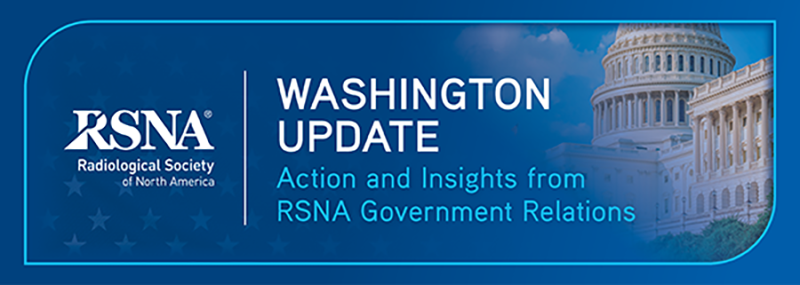Government Relations
Discover how RSNA amplifies radiology’s role in advancing health care delivery and medical imaging innovation through its government outreach efforts, partnerships and advocacy.
On this page
Overview
RSNA’s government relations efforts seek to elevate and amplify radiology’s voice by:
- Promoting a greater understanding among federal policymakers of radiology and its role in advancing public health and biomedical imaging innovation
- Impacting the development of policy, regulations and legislation related to existing and emerging medical imaging technologies
- Promoting research and development initiatives and opportunities to advance scientific knowledge and enhance patient care and health care delivery
Overview
RSNA’s government relations efforts seek to elevate and amplify radiology’s voice by:
- Promoting a greater understanding among federal policymakers of radiology and its role in advancing public health and biomedical imaging innovation
- Impacting the development of policy, regulations and legislation related to existing and emerging medical imaging technologies
- Promoting research and development initiatives and opportunities to advance scientific knowledge and enhance patient care and health care delivery

RSNA Committee on Government Relations
Committee charge
The RSNA Committee on Government Relations will create and execute a government outreach strategy aligned with RSNA’s mission of promoting excellence in patient care and health care delivery through education, research and technological innovation. Learn more about the committee’s charge and members.
Three subcommittees have been established to help carry out the work of RSNA’s government relations:
- Education & Engagement subcommittee
- Research subcommittee
- Technology & Practice subcommittee

Policy priorities
RSNA’s public policy initiatives focus on elevating the expertise of radiologists to inform pressing challenges in medical research and patient care.
Key issues include:
- AI in medical imaging
- Theranostics
- Federal investment in biomedical and health research
Recent activities
-
RSNA jointly urges Congress to provide robust funding for the NIH in 2025
RSNA joined over 600 biomedical and health research stakeholder organizations in urging congressional leadership to provide robust funding for the National Institutes of Health (NIH) and to preserve protections against harmful policy changes to facilities and administrative (F&A) costs on NIH grants. View the coalition letter.
-
RSNA responds to a Request for Information from the Trump Administration seeking feedback on its development of an AI Action Plan
RSNA’s comments identified five key considerations in the development of an AI Action Plan including, among others, the need to foster trust through robust validation and transparency; encourage innovation through strategic R&D; and reduce barriers to AI adoption through effective and efficient regulatory pathways. Read the full letter.
-
RSNA responds to the CDC's proposal to expand the B reader program
The B Reader program certifies physicians in the ability to classify chest radiographs for pneumoconiosis and is used by the Centers for Disease Control (CDC) in some of its health surveillance programs. RSNA cautioned the CDC against expanding the B Reader program to allow nurse practitioners and physician assistants to become certified B Readers and recommended that when non-physician providers are involved in medical imaging and radiologic care, they contribute as part of a radiologist-led team and do not focus on independent image interpretation. Read the full letter.
-
RSNA submits comments to the FDA regarding the new Digital Health Advisory Committee (DHAC)
Following the first meeting of the DHAC in November 2024, RSNA’s letter made several recommendations regarding the ways in which modifications to the Food and Drug Administration's (FDA) regulatory framework can promote enhanced transparency in AI tool development, deployment and continuous monitoring. In addition, RSNA strongly encouraged the FDA to ensure that the DHAC continues to draw on the expertise of radiology and radiologists in its work. Read the full letter.
-
RSNA responds to the FDA's draft guidance for Predetermined Change Control Plans (PCCP) for AI enabled medical devices
RSNA’s comments focused on how the proposed PCCP guidance for AI-enabled devices might interact with health care provider responsibilities and the monitoring process associated with enforcement and deviation from these plans. Read the full letter.
-
RSNA submits comments to the Department of Health and Human Services (HHS) on the Health Data, Technology, and Interoperability (HTI-2) proposed rule
RSNA’s comments asserted the Society’s support for HHS’ proposal to add imaging links to the certification criteria for electronic health records but noted that developers and vendors of imaging systems will require regulatory guidance, specifying exchange standards and behaviors to resolve imaging links. Read the full letter.
-
RSNA responds to a Request for Information from the NIH’s All of Us Precision Medicine Research Program
RSNA submitted comments in response to a request for information from the NIH seeking comments on potential future data linkages for the All of Us Precision Medicine Research Program.
RSNA’s response recommends that the All of Us Program incorporate linkages to imaging databases, namely the NIH-funded Medical Imaging and Data Resource Center (MIDRC). MIDRC is a collaborative initiative co-led by RSNA, the American College of Radiology (ACR), and the American Association of Physicists in Medicine (AAPM) and hosted at the University of Chicago.
-
Artificial Intelligence-Enabled Device Software Functions: Lifecycle Management and Marketing Submission Recommendations
-
Subcommittee on Labor, Health and Human Services, Education, and Related Agencies House Appropriations Committee
Washington Update
Washington Update is a monthly newsletter about current federal policy developments and RSNA’s initiatives to advance radiology on Capitol Hill.
Current issue
Washington Update - September 2025
